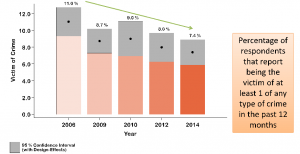THIS is the third of three articles written by the authors. The articles are focused on the issues of trust, corruption and violence. To assist us, we have tapped the University of Vanderbilt’s Latin America Public Opinion Project (LAPOP). This survey of public opinion has been conducted in Guyana since 2006 and is perhaps the only such comprehensive dataset available. We consider that it is sufficiently objective to be used widely and without any serious challenge to its credibility. The dataset is available free of charge at The AmericasBarometer by the Latin American Public Opinion Project (LAPOP), www.LapopSurveys.org.
In our series we strive to offer zero ‘answers’, while presenting the data in accessible and dispassionate prose. We certainly cannot claim to have conclusively resolved any of the challenges Guyana faces, but we hope to contribute towards the forging of a wider, more comprehensive and trusting consensus on some key issues. Indeed, we know that to create policy, rigorous assessment of existing data and contextualising within a regional and global environment would be required.
Data on violence in the LAPOP study is limited. We therefore have turned to other sources to assist us in the preparation of this article.
Nothing threatens human existence as obviously as violence. Human security thus naturally includes physical security. Insecurity drives up the cost of doing business, to add economic insult to the threat of physical injury.
While the global homicide rate has decreased from 8.0 homicides to 6.7 per 100,000 people between 2000 and 2012, the levels in Latin America and the Caribbean have increased, from 27.1 to 28.5 homicides per 100,000 people. This regional homicide level is the highest in the world, with Africa next in line at a distant 10.9. (UN Office on Drugs and Crime, UNODC – Global status report on violence prevention 2014).
What drives this level of violence in our Region? Data-based evidence is hard to come by and we were forced to look beyond the LAPOP dataset for more information. Several researchers suggest that the main drivers for violence in Latin America and the Caribbean are social and economic exclusion, including frustration with the justice system and police. The LAPOP 2014 Survey indicates that two of the three least trusted institutions in Guyana, are the judicial system and the police, the third being political parties. The problem is further exacerbated by drugs, with accompanying gangs and firearms (International Journal of Conflict and Violence, 2011). This seems to be confirmed by the regular media reports that drugs and firearms feature prominently in the country’s crime.
The UNODC (2014) also reports that Guyana’s intentional homicide rate in 2011 was 17.0 per 100,000 inhabitants, with the ratio of female to male homicides being the highest in the Americas (40.0%/60.0%). While the rate is lower than the regional average, and lower than the three Caribbean comparators of Jamaica (42.0), Trinidad (28.6) and Brazil (24.3), Guyana’s rate is still twice the global average. When asked their opinion on the most important problem facing the country, 27.0% of the Guyanese respondents in the LAPOP 2014 survey pointed to security-related issues (the economy stood at 31.5%, with politics – inclusive of corruption, poor government and politicians – at 25.6%).
Relative to the region, the LAPOP reported level of crime victimisation (that is, being a crime victim) has been dropping over the years (see Figure 1) and is currently the second lowest in the countries surveyed in the region (see Figure 2). When the type of crime is disaggregated over the period 2010-2014 (earlier years used a slightly different question that make comparisons difficult), two key findings emerge: of the persons surveyed, armed robbery has decreased from 26.5% to 14.3% while unarmed robbery rose from 32.4% to 42.0%.
Crime in rural areas was experienced at a higher level than in urban areas (60.0% vs. 40.0%) of the survey pool. 44.7% of crimes affecting respondents, took place in the home. When asked how long they felt the police would take to come if they called for help, almost 60% of respondents said more than 1 hour, if the police came at all.
Violence within Families
Guyanese have been worried for some time now about levels of domestic violence. The level of approval for domestic violence is high (35.6%), as measured by the acceptance of husbands hitting unfaithful wives. Over 30.0% would accept hitting if the wife neglected chores.
Violence to oneself as measured by suicide rates sees Guyana being rated at the highest level in the world – 44.2 per 100,000 persons (WHO, 2014). A suicide case in Guyana is three times more likely to involve a male than a female.
Domestic violence and suicide are both acts of violence within a family unit. Taken together, the data suggest that the rate of violence within family units is elevated. Considering the importance of family life in creating a healthy and cohesive society, what do these figures mean for our society in the near to medium term future?
Among the further questions generated by the LAPOP 2014 findings on violence are:
• What are the main drivers of the different kinds of violence in Guyana?
• What explains the gap between Guyana’s high level of homicide and low level of experienced crime?
• Do citizens perceive the crime level to be higher than it actually is? If so, why?
• What are the connections between violence and demographics such as gender, ethnicity and age?
• What can we expect in the future, given the high level of violence experienced within our family units?




.jpg)








